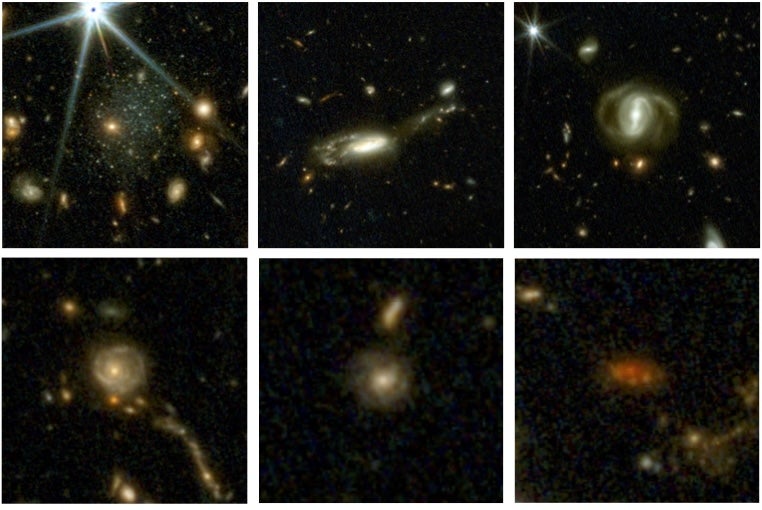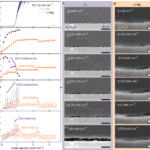2025-06-05 カリフォルニア大学サンタバーバラ校(UCSB)

Photo Credit:M. Franco / C. Casey / COSMOS-Web collaboration
Six images of galaxies taken from nearly 800,000, from upper left to lower right: the present-day universe, and 3, 4, 8, 9 and 10 billion years ago
カリフォルニア大学サンタバーバラ校(UCSB)などが主導する国際研究チーム「COSMOS」は、ジェームズ・ウェッブ宇宙望遠鏡(JWST)のデータを活用し、約135億年分の宇宙史をカバーするこれまでで最大規模の宇宙地図「COSMOS-Webフィールド」を公開しました。この地図には約80万個の銀河が含まれ、初期宇宙における銀河、星、ブラックホールの形成過程を明らかにする貴重な情報を提供しています。
JWSTの高感度観測によって、ビッグバンからわずか4億年後の段階ですでに多数の銀河が存在していたことが判明し、これは従来の予測の約10倍に相当します。さらに、従来の観測では捉えられなかった超大質量ブラックホールの存在も多数確認され、宇宙初期に想定以上の光が生成されていた可能性が示唆されました。
この発見は、既存の宇宙論モデルの見直しや、暗黒物質、初期宇宙の物理法則の再評価に大きな影響を与えると期待されています。COSMOSチームは今後、これらの銀河の距離や化学組成を分光観測で精査し、宇宙進化のさらなる理解に取り組む計画です。
<関連情報>
- https://news.ucsb.edu/2025/021905/mapping-space-largest-map-universe-announced
- https://cosmos2025.iap.fr/fitsmap/?ra=150.0314116&dec=2.3583717&zoom=4
- https://www.aanda.org/articles/aa/full_html/2025/05/aa53759-25/aa53759-25.html
- https://iopscience.iop.org/article/10.3847/1538-4357/acc2bc
COSMOS-Webによるz = 3.7までの深部銀河群カタログ The COSMOS-Web deep galaxy group catalog up to z = 3.7
Greta Toni, Ghassem Gozaliasl, Matteo Maturi, Lauro Moscardini, Alexis Finoguenov, Gianluca Castignani, Fabrizio Gentile, Kaija Virolainen, Caitlin M. Casey, Jeyhan S. Kartaltepe, Hollis B. Akins, Natalie Allen, Rafael C. Arango-Toro, Arif Babul,, Malte Brinch, Nicole E. Drakos, Andreas L. Faisst, Maximilien Franco, Richard E. Griffiths, Santosh Harish, Günther Hasinger, Olivier Ilbert, Shuowen Jin,, Ali Ahmad Khostovan, Anton M. Koekemoer, Maarit Korpi-Lagg, Rebecca L. Larson, Jitrapon Lertprasertpong, Daizhong Liu, Georgios Magdis, Richard Massey, Henry Joy McCracken, Jed McKinney, Louise Paquereau, Jason Rhodes, Brant E. Robertson, Mark Sargent, Marko Shuntov, Masayuki Tanaka, Sina Taamoli, Elmo Tempel, Sune Toft, Eleni Vardoulaki and Lilan Yang
Astronomy & Astrophysics Published:19 May 2025
DOI:https://doi.org/10.1051/0004-6361/202553759
Abstract
Context. Galaxy groups with total masses below ∼1014 M⊙ and up to a few tens of members are the most common galaxy environment, marking the transition between the field and the most massive galaxy clusters. In this framework, identifying and studying groups plays a crucial role in understanding structure formation and galaxy evolution. Despite the challenges in detecting such relatively small structures, modern deep surveys allow us to build well-characterized samples of galaxy groups up to the regime where the structures we observe today were taking shape.
Aims. We aim to build the largest deep catalog of galaxy groups to date over the COSMOS-Web field effective area of 0.45 deg2.
Methods. We leveraged the deep imaging, high resolution, and high-quality photometry from the James Webb Space Telescope observations of the COSMOS-Web field. We used the recent COSMOS-Web photometric catalog with sky position, photometric redshift, and magnitude in a reference band for each selected galaxy. We performed the group search with the Adaptive Matched Identifier of Clustered Objects (AMICO) algorithm, a linear matched filter based on an analytical model for the cluster/group signal. This algorithm has already been tested in wide and deep field surveys, including a successful application to COSMOS data up to z = 2. In this work, we tested the algorithm’s performances at even higher redshift and searched for protocluster cores and groups at z > 2. To benchmark this relatively unexplored regime, we compiled a list of known protoclusters in COSMOS at 2 ≤ z ≤ 3.7 and matched them with our detections. We studied the spatial connection between detected cores through a clustering analysis. We estimated the purity and the completeness of our group sample by creating data-driven mocks via a Monte Carlo approach with the SinFoniA code and linked signal-to-noise to purity levels to define desired purity thresholds.
Results. We detected 1678 groups in the COSMOS-Web field up to z = 3.7 with a purity level of ∼77%, providing a deep catalog of galaxy members that extends nearly two magnitudes deeper than the previous application of AMICO to COSMOS. Around 670 groups have been detected with a purity of 90%. Our catalog includes more than 850 groups whose photometric redshift was confirmed by assigning robust spectroscopic counterparts.
Conclusions. This catalog of galaxy groups is the largest ultra-deep group sample built on JWST observations so far and offers a unique opportunity to explore several aspects of galaxy evolution in different environments spanning ∼12 Gyr and study groups themselves, from the least rich population of groups to the formation of the most massive clusters.
OSMOS-Web JWST宇宙起源サーベイの概要 COSMOS-Web: An Overview of the JWST Cosmic Origins Survey
Caitlin M. Casey, Jeyhan S. Kartaltepe, Nicole E. Drakos, Maximilien Franco, Santosh Harish, Louise Paquereau, Olivier Ilbert, Caitlin Rose, Isabella G. Cox, James W. Nightingale,…
The Astrophysical Journal Published 2023 August 21
DOI:10.3847/1538-4357/acc2bc
Abstract
We present the survey design, implementation, and outlook for COSMOS-Web, a 255 hr treasury program conducted by the James Webb Space Telescope in its first cycle of observations. COSMOS-Web is a contiguous 0.54 deg2 NIRCam imaging survey in four filters (F115W, F150W, F277W, and F444W) that will reach 5σ point-source depths ranging ∼27.5–28.2 mag. In parallel, we will obtain 0.19 deg2 of MIRI imaging in one filter (F770W) reaching 5σ point-source depths of ∼25.3–26.0 mag. COSMOS-Web will build on the rich heritage of multiwavelength observations and data products available in the COSMOS field. The design of COSMOS-Web is motivated by three primary science goals: (1) to discover thousands of galaxies in the Epoch of Reionization (6 ≲ z ≲ 11) and map reionization’s spatial distribution, environments, and drivers on scales sufficiently large to mitigate cosmic variance, (2) to identify hundreds of rare quiescent galaxies at z > 4 and place constraints on the formation of the universe’s most-massive galaxies (M⋆ > 1010M⊙), and (3) directly measure the evolution of the stellar-mass-to-halo-mass relation using weak gravitational lensing out to z ∼ 2.5 and measure its variance with galaxies’ star formation histories and morphologies. In addition, we anticipate COSMOS-Web’s legacy value to reach far beyond these scientific goals, touching many other areas of astrophysics, such as the identification of the first direct collapse black hole candidates, ultracool subdwarf stars in the Galactic halo, and possibly the identification of z > 10 pair-instability supernovae. In this paper we provide an overview of the survey’s key measurements, specifications, goals, and prospects for new discovery.



